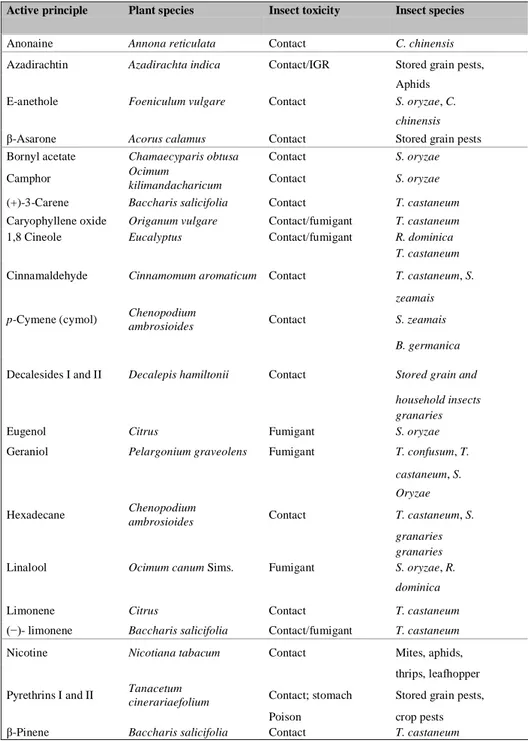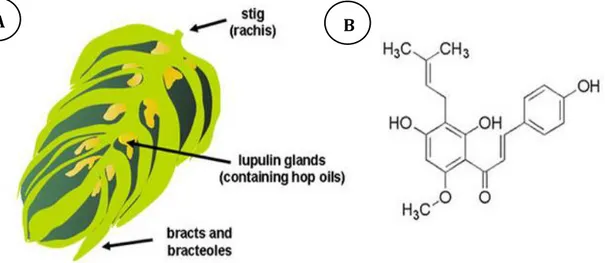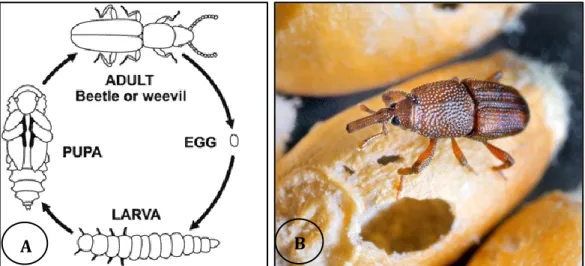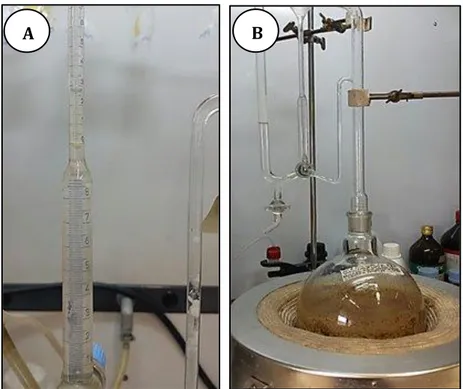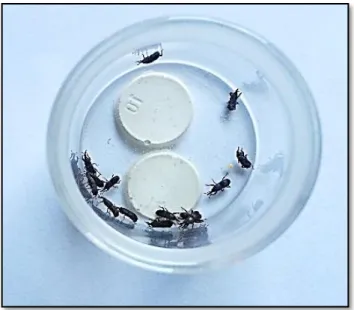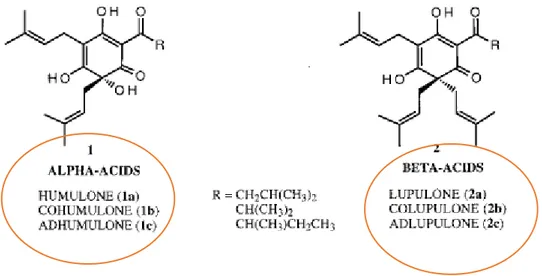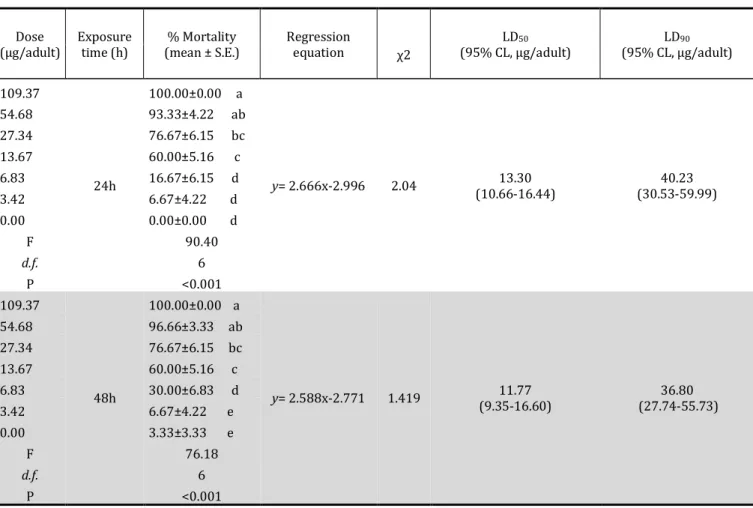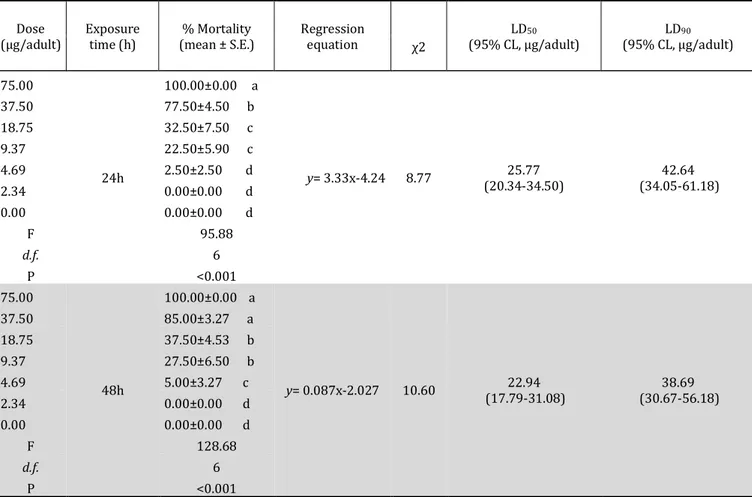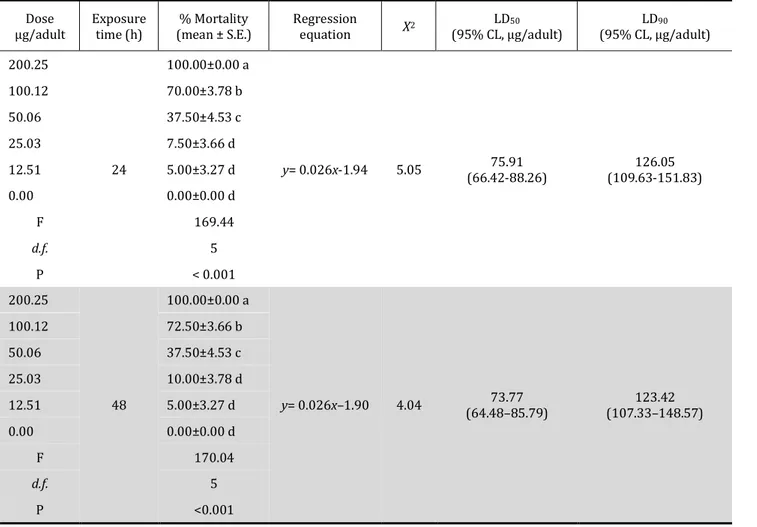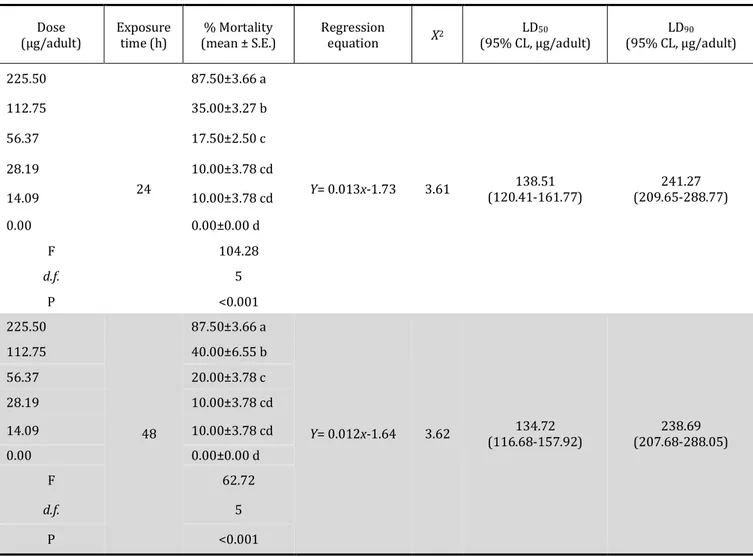UNIVERSITÀ DEGLI STUDI DEL MOLISE
Department of Agricultural, Environmental and Food Sciences
PhD Course in:
A
GRICULTURET
ECHNOLOGY ANDB
IOTECHNOLOGY(CURRICULUM: SUSTAINABLE PRODUCTION AND PROTECTION OF PLANTS)
(C
YCLEXXXI)
Related disciplinary scientific section AGR/11 (Entomologia)
PhD thesis
Characterisation of different hop ecotypes (Humulus
lupulus, L.) in Central Italy and evaluation of the
biological activity of their extracts, EO and components
against Sitophilus granarius (L.)
Coordinator of the PhD Course: Prof. Giuseppe Maiorano
Supervisor: Prof. Giuseppe Rotundo
Co-Supervisors: Prof. Antonio De Cristofaro
Prof. Stefano Benedettelli
PhD Student: Laura De Acutis
153775
2 Ph.D. thesis of Laura De Acutis
“….Dicono che c'è un tempo per seminare
E uno più lungo per aspettare
Io dico che c'era un tempo sognato
Che bisognava sognare….”
“C’è tempo”, Ivano Fossati
3 Ph.D. thesis of Laura De Acutis
TABLE OF CONTENTS Page Abstract 7 Riassunto 10 Chapter 1~ Introduction 11 1.1. AROMATIC PLANTS 11
1.1.1. The ecotypes: concept and definition 12
1.2. HOP (Humulus lupulus L.) 14
1.2.1. Taxonomy 15
1.2.2. Pharmacognosy oh hops 15
1.3. TOXICITY AND MODE OF ACTION OF INSECTICIDES 17
1.3.1. Inhibition of acetylcholinesterase 18
1.3.2. EOs: definition and their important properties 19
1.4. COMPOSITION OF SECONDARY METABOLITES OF HOP 21
1.4.1. Insecticidal effects of hops 24
1.5. INSECT 25
1.5.1. Coleoptera 25
1.5.2. Classification of beetles 27
1.5.3. Dryophthoridae family 29
1.5.4. The granary weevil: Sitophilus granarius (L.) 30
1.5.5. Region of origin and dissemination of the Sitophilus
species 32
1.5.6. Prevention and control of S. granarius 33
Chapter 2~ Aim of the work 35
Chapter 3~Materials and methods 36
3.1. EVALUATION OF BIOLOGICAL ACTIVITY 36
3.1.1. Plant materials 36
3.1.2. Plant extracts 37
3.1.3. Compounds tested 38
3.1.4. Gas chromatography-mass spectrometry (GC-MS) 38
4 Ph.D. thesis of Laura De Acutis
3.1.6. Contact toxicity 40
3.1.7. Repellency in arena 41
3.1.8. Fumigant toxicity 42
3.1.9. Antifeedant and nutricional effects 43
3.1.10. AChE assay 45
3.2. CHARACTERIZATION OF HOP ECOTYPES 45
3.2.1. Plant ecotypes 45
3.2.2. Extraction of polyphenols 47
3.2.3. Determination of alpha and beta acids content 50
3.2.4. AChE on free and bound fractions 51
Chapter 4~Results/1 evaluation of biological activity 52
4.1. EO CHARACTERIZATION 53
4.2. CONTACT TOXICITY 55
4.3. REPELLENCY IN ARENA 63
4.4. INHALATION TOXICITY 70
4.5. ANTIFEEDANT AND NUTRICIONAL EFFECTS 75
4.6. AChE ASSSAYS 77
Chapter 5~Results/2 characterization of hop ecotypes 77
5.1. POLYPHENOLS CONTENT 78
5.2. ARP AND ANTICHOLINESTERASE ACTIVITY 80
5.3. ALPHA AND BETA ACIDS CONTENT 84
Chapter 6~Discussion 85
Chapter 7~Conclusions 89
Chapter 6~References 92
Web references 107
5 Ph.D. thesis of Laura De Acutis
ABSTRACT
The indiscriminate use of synthetic insecticides for several decades has raised long-term human health and environmental concerns, mainly due to their slow degradation in the environment and toxic residues in the products, as well as the evolution of resistance to pesticides in pest populations (Isman, 2006). The serious problems of insecticide resistance in pests and the contamination of the biosphere associated with large scale use of synthetic pesticides have led to the search for eco-friendly pesticides with greater selectivity to the pests. This awareness has created a worldwide interest in the development of alternative strategies, including the discovery of newer insecticides that are more environmentally friendly than synthetic chemicals (Rajashekar et al., 2012a, b; Miresmailli and Isman 2014).
In this context, the use of insecticides based on botanical extracts is attracting considerable interest among both researchers and consumers.
It’s known that various plant compounds bind to some biological macromolecules (mainly proteins), interacting with specific sites inside the cells. Lately, the study on the interactions among natural substances and cellular components has assumed an important role in the development of synthetic medicines/drugs/compounds. This could encourage the identification of new plant compounds/extracts with biological activity since they constitute the basis for new biotechnological approaches to plant defense and its management. Therefore, in addition to new classes of insecticides, chemicals that have different modes of action are needed to maintain stable food production (Gokce et al., 2012). Most plants defend themselves from herbivory through production of secondary compounds such as terpenes, phenolics and nitrogen-containing compounds (Taiz and Zeiger, 2010). Some of these secondary compounds, including pyrethrin and rotenone, produce direct toxicity, while others cause either physiological disruption as caused by growth regulators or behavioral effects as repellents, attractants or antifeedants (Isman, 1999; Gokce et al., 2006).
6 Ph.D. thesis of Laura De Acutis
Hop (Humulus lupulus L.) is a high-climbing, perennial vine, utilized in the brewing industry to add flavor and bitterness to beer (Chadwick et al., 2006) whose production has been estimated at over 100.000 tons worldwide (FAOSTAT, 2014).
However, aerial parts of this plant produces several secondary metabolites as bitter resins, essential oil (EO), tannins and terpenes, proved to have biological activities: xanthohumol was reported to show anticancer and antioxidant effects (Colgate et al., 2010); hop iso-α-acids positively affect glucose metabolism, diet-induced obesity and its relative cognitive decline in rodents (Miura et al., 2005; Yajima et al., 2005; Ayabe et al. 2018); main compounds of EO such as α-humulene, α-myrcene and β-caryophyllene showed antimicrobial activities against different strains of Gram-positive and Gram-negative bacteria (Stompor and Zarowska 2016). Moreover, besides medical purposes (Bocquet et al., 2018a), the interest in hop extracts/compounds is increasing in the light of a their possible use also in pest control (Bocquet et al., 2018b). In particular, several papers highlighted activities against insect due to both antifeedant and repellent activities for hop extracts or EO compounds of this plant (DeGrandi et al 2012; Powell et al 1997).
Aim of the present study is to gain a further insight into wild hop properties. Thus, in a first part the biological activity of …hop extracts, EO and its principal chemical compounds (α-humulene, α-myrcene and β-caryophyllene) against the granary weevil Sitophilus granarius (L.) (Coleoptera Dryophthoridae) was investigated;subsequently, the attention was focused on the characterization of hop ecotypes in different locations of Central Italy (Abruzzo, Molise) in order to identify the best one in terms of polyphenols content associated with a high antioxidant power
.
The terpenes, α-humulene, β-myrcene and β-caryophyllene were the main components (77.6%) of EO.
Among all chemical compounds and extracts tested, EO was able to exert the highest contact toxicity with LD50 and LD90 values of 13.30 and 40.23 µg/adult after 24 h of application, decreasing to 11.77 and 36.80 µg/adult after 48 h, respectively.
7 Ph.D. thesis of Laura De Acutis
Between solvent extracts the most active was the one in acetone while among compounds the greatest contact toxicity was observed for α-humulene.
Moreover, α-humulene was able to exert the highest average RI (-38.89) against S. granarius adults.
As regards to inhalation toxicity, the highest fumigant activity was observed for ß-myrcene with LC50 and LC90 values of 72.78 and 116.92 mg/L in the absence of grain, and 115.78 and 171.42 mg/L in the presence of it.
The highest ingestion mortality was detected in acetone extract while the greatest deterrence was found for methanol extract.
Negligible anticholinesterase activity was found for all substances in the checked range, with the only exception of ß-caryophyllene which showed a dose dependent inhibitory effect, whereas all free fractions of polyphenols showed anticholinesterase activity.
The highest polyphenols content was found for the ecotype collected in 99 Cannelle (78.28 mg/g of dry weight) associated with the highest anticholinesterase activity.
Finally, the highest content of alpha and beta acids was recorded in the sample collected in Bussi.
This study indicate that wild hop is a source of biological substances which are active on S. granarius adults by contact, ingestion and fumigant toxicity, to be also utilized as low-cost, eco-friendly pests repellents in the protection of stored food.
Moreover, the results confirm that the examined hop ecotypes show significant differences in the content of polyphenols, which determine different antioxidant and anti-cholinesterase activities. The latter, in particular, could be responsible for the insecticidal action found previously in alcoholic extracts of ecotypes. These results highlight the need to define the chemical composition of the various fractions in order to characterize the various ecotypes and identify the biologically active molecules.
8 Ph.D. thesis of Laura De Acutis
RIASSUNTO
L'uso indiscriminato di insetticidi sintetici per diversi decenni ha sollevato preoccupazioni per la salute umana, principalmente a causa del loro lento degrado nell'ambiente, dei residui tossici da essi rilasciati e dell'evoluzione della resistenza ai pesticidi nelle popolazioni di parassiti (Isman, 2006).
I gravi problemi di resistenza agli insetticidi nei parassiti e la contaminazione della biosfera associata all'uso su larga scala di pesticidi sintetici, hanno portato alla ricerca di prodotti eco-compatibili con maggiore selettività.
Questa consapevolezza ha creato un interesse mondiale nello sviluppo di strategie alternative, compresa la scoperta di nuovi insetticidi più ecologici rispetto alle sostanze chimiche sintetiche (Rajashekar et al.,2012a, b; Miresmailli e Isman, 2014).
In questo contesto, l'impiego di insetticidi a base di estratti botanici sta suscitando un notevole interesse sia tra i ricercatori che tra i consumatori. È noto che vari composti vegetali si legano ad alcune macromolecole biologiche (principalmente proteine), interagendo con siti specifici all'interno delle cellule. Ultimamente, lo studio sulle interazioni tra sostanze naturali e componenti cellulari ha assunto un ruolo importante nello sviluppo di farmaci sintetici. Ciò potrebbe incoraggiare la ricerca verso l'identificazione di nuovi composti/estratti con attività biologica in quanto costituiscono la base per nuovi approcci biotecnologici alla difesa delle piante e alla loro gestione.
Oltre alle nuove classi di insetticidi, sono però necessarie sostanze chimiche che presentano diverse modalità di azione, in modo da mantenere una produzione alimentare stabile (Gokce et al., 2012).
La maggior parte delle piante si difende dagli erbivori attraverso la produzione di metaboliti secondari come terpeni, composti fenolici e composti contenenti azoto (Taiz and Zeiger, 2010). Alcuni di questi, tra cui piretrina e rotenone, provocano tossicità diretta, altri causano interruzioni fisiologiche (regolatori della crescita) ed altri ancora vengono utilizzati come repellenti, attrattivi o anti-nutrizionali (Isman, 1999; Gokce et al., 2006).
9 Ph.D. thesis of Laura De Acutis
Il luppolo (Humulus lupulus L.) è una pianta perenne e rampicante, utilizzata nei birrifici per aggiungere l’amaro e l’aroma alla birra (Chadwick et al., 2006) la cui produzione è stata stimata di oltre 100.000 tonnellate in tutto il mondo (FAOSTAT, 2014). Tuttavia, parti aeree di questa pianta, producono diversi composti secondari come resine amare, olio essenziale (OE), tannini e terpeni ed hanno dimostrato avere attività biologiche: xantumolo, il principale prenilflavonoide, è stato segnalato possedere effetti antitumorali e antiossidanti (Jacob et al., 2010; Colgate et al ., 2010); gli iso-α-acidi del luppolo influenzano positivamente il metabolismo del glucosio, l'obesità indotta dalla dieta e il relativo declino cognitivo nei roditori (Hiroaki Yajima et al., 2004; Miura et al., 2005; Yajima et al., 2005; Ayabe et al., 2018); i principali composti dell’ OE come α-umulene, β-mircene e β-cariofillene hanno mostrato attività antimicrobiche contro diversi ceppi di batteri Gram-positivi e Gram-negativi (Stompor e Zarowska, 2016). Inoltre, oltre agli impieghi in campo medico (Bocquet et al., 2018), l'interesse per gli estratti/composti derivati dal luppolo sta aumentando, alla luce di un loro possibile utilizzo anche nel controllo dei parassiti.
In particolare, diversi articoli hanno evidenziato (Bocquet et al., 2018), attività antinutrizionale e repellente di estratti di luppolo e composti dell’OE di questa pianta (DeGrandi et al., 2012; Powell et al., 1997).
Pertanto, nel presente studio l'attenzione è stata focalizzata sull’utilizzo di luppolo selvatico e sulla valutazione dell'attività biologica di estratti, OE e dei suoi principali composti (α-umulene, β-mircene e β-cariofillene) contro il tonchio del grano Sitophilus granarius (L.) (Coleoptera Dryophthoridae). Successivamente, l'attenzione è stata focalizzata sulla caratterizzazione degli ecotipi di luppolo in diverse località dell'Italia centrale (Abruzzo e Molise) al fine di individuarne il migliore in termini di contenuto in polifenoli, associato ad un elevato potere antiossidante.
I terpeni, α-umulene, β-mircene e β-cariofillene sono risultati i componenti principali (77,6%) dell’OE.
Tra tutti i composti chimici e gli estratti testati, l'OE è stato in grado di esercitare la massima tossicità di contatto con valori di LD50 e LD90 di 13,30 e 40,23
μg/adulto dopo 24 ore dall'applicazione, diminuendo a 11,77 e 36,80 μg/adulto dopo 48 ore, rispettivamente. Tra gli estratti in solvente il più attivo è stato
10 Ph.D. thesis of Laura De Acutis
quello in acetone, mentre tra i composti la maggiore tossicità da contatto è stata riscontrata per l'α-umulene.
Inoltre, l’α-humulene ha mostrato il miglior indice di repellenza (IR) (-38,89) contro gli adulti di S. granarius.
Per quanto riguarda la tossicità per inalazione, la massima attività fumigante è stata osservata per il ß-mircene con valori di LC50 e LC90 di 72,78 e 116,92 mg/L
in assenza di grano e 115,78 e 171,42 mg/L in presenza di esso.
La massima mortalità per ingestione è stata rilevata nell'estratto in acetone, mentre la maggiore deterrenza per l'estratto in metanolo.
L'attività anticolinesterasica è risultata trascurabile per tutte le sostanze, con la sola eccezione del ß-cariofillene, che ha mostrato un effetto inibitorio dose-dipendente, ad eccezione, invece, tutte le frazioni libere di polifenoli che hanno mostrato una buona attività anticolinesterasica.
Il più alto contenuto in polifenoli è stato trovato nell’ecotipo raccolto nelle “99 Cannelle” (78,28 mg/g di peso secco) associato alla migliore attività anticolinesterasica.
Infine, il contenuto più elevato in alfa e beta acidi è stato registrato nel campione raccolto in “Bussi”.
Questo studio indica che il luppolo selvatico potrebbe rappresentare una fonte di sostanze biologicamente attive verso adulti di S. granarius, in quanto ha mostrato una buona tossicità per contatto, ingestione e inalazione, da utilizzare anche come repellente a basso costo ed eco-compatibile nella protezione degli alimenti conservati.
Inoltre, i risultati confermano che gli ecotipi di luppolo esaminati mostrano differenze significative nel contenuto in polifenoli, che determinano diverse attività antiossidanti e anti-colinesterasiche. Quest'ultime, in particolare, potrebbero essere responsabili dell'azione insetticida riscontrata precedentemente negli estratti alcolici di alcuni ecotipi. Questi risultati evidenziano, per cui, la necessità di definire la composizione chimica delle varie frazioni al fine di caratterizzare i diversi ecotipi e identificare le molecole biologicamente attive.
11 Ph.D. thesis of Laura De Acutis
C
hapter 1~ Introduction1.1. AROMATIC PLANTS
The growing interest of consumers in substances of natural origin in addition to the increasing concern surrounding potentially harmful synthetic additives has resulted in the use of aromatic plants, their extracts and essential oils, as functional ingredients in the pharmaceutical, food and feed industries (Marshall, 2011; Sacchetti et al., 2005).
Medicinal and aromatic plants (Figure 1.1) play a significant role in the life of people and are present in innumerable forms. A simplest definition of the medicinal plant would be “Medicinal plants are those plants which are used in official and various traditional systems of medicines throughout the world”. Other definition could be “Medicinal plants are plants that provide people with medicines to prevent disease, maintain health or cure ailments”.
Aromatic plants, also known as herbs and spices, have been used in the Middle East since approximately 5000 BC for their preservative and medicinal properties, in addition to enhancing the aroma and flavor of foods (Chang 2000; Piccaglia et al., 1993).
Additionally, feed additives derived from plants, also called phytogenics or phytobiotics or botanicals, can be included in animal diets to improve their
12 Ph.D. thesis of Laura De Acutis
productivity and the properties of the resulting feed and animal products (Windisch et al., 2009). Among these natural additives, aromatic plants, their extracts and their essential oils have been examined due to their advantages over the antibiotics as growth promoters. They are residue free and generally recognized as safe.
Medicinal and aromatic plant is obtained both from plants growing in the wild and from cultivated stock. Collection of ecotypes plays a vital role in the use of, and trade in, medicinal and aromatic plant material in Europe, since cultivation has not proved to be profitable for the majority of taxa in trade. This is because: many aromatic plants are difficult to cultivate; many are required in small quantities; the quality of some wild- harvested material is supposed superior; the cost associated with obtaining plant material from the wild are relatively low (Lange and Schippmann,1997; Lange, 1998, 2002).
1.1.1. THE ECOTYPES: CONCEPT AND DEFINITION
The process by which one species diverges into two distinct phylogenetic lineages has long fascinated biologists.
Thus, biologists have found that dividing speciation into stages is a useful framework for better understanding the entire process (Wallace, 1865; Turesson, 1922a, b; Clausen, 1951; Grant, 1981; Wu, 2001; Nosilet et al., 2009).
In two papers, published in 1922, Turesson (1922 a, b) introduced the ecotype concept and its importance in the study of the constitution and origin of species was almost immediately recognized.
The first term used by Turesson (1922a, p. 102) is ecospecies, but this is not immediately defined. In the same paper (p. 112) we read: 'The term ecotype is proposed here as [an] ecological unit to cover the product arising as a result of the genotypical response of an ecospecies to a particular habitat. The ecotypes are then the ecological sub-units of the ecospecies, while the genotypes are purely Mendelian sub-units of the genospecies.' In the second, longer, paper of
13 Ph.D. thesis of Laura De Acutis
has been proposed (Turesson, 1922) to cover the Linnean species or genotype compounds as they are realized in nature.'
Hanson and Churchill (1961) define ecotype as a cluster of biotypes, within a species, occupying a particular habitat. A biotype, according to this definition, is a population of a species within a given microhabitat belonging to one genotype. For the most part, an ecotype is designated herein by a species, and biotypes by varieties of that species. Each species (ecotype) in this report may contain as many as six varieties (biotypes) that have similar ecological affinities based on repeated co-occurrence in the study area. Subsequently, an ecotype is identified as a single variety because it is presumed to be ecologically distinct from another variety that is also found in the study area. In some instances, a form or even another closely related species is designated as a biotype; the ecological counterpart for form is ecoform (phenotype) and for another closely related species is ecospecies.
During the 1980s and 1990s, there was less discussion in the literature regarding ecotypes and stages in speciation.
Linhart & Grant (1996), who conducted the most comprehensive review of local adaptation in the 1990s, suggested that ‘some characters can vary gradually, others discontinuously, depending on, for example, gene flow, intensity of selection, number of genes involved, and terrain configuration’ (Linhart and Grant, 1996). It is true that individual traits may vary in different ways but, ecotypes reflect the composite response of multiple traits to the common selection pressures of ecoregions.
Early in the last decade, Wu (2001) presented a ‘genic view of the process of speciation’ where he reframed speciation as the product of the accumulation of genic incompatibilities across the genome over time by natural selection. Interestingly, Wu presented the process of speciation as occurring over four stages, which reflected the gradual build up of regions of the genome that could no longer introgress between diverging races or species.
14 Ph.D. thesis of Laura De Acutis
1.2 HOP (Humulus lupulus L.)
Hop (Humulus lupulus Linnaeus) (Figure 1.2) is a dioecious, hight-climbing and perennial plant belonging to the Cannabaceae family of the Urticales order (Roberts and Wilson, 2006). Besides the common hop, the Humulus genus includes 2 other species, Humulus japonicus Siebold & Zucc and Humulus yunnanensis Hu, but only Humulus lupulus is of industrial/medical importance (Van Cleemput and others, 2009a).
The centre of origin of the genus is considered to be China, because all Humulus species have been found in this area (Neve, 1991; Murakami et al., 2006). H. japonicuc is native to Japan, Taiwan and China, while H. yuannensis is native to high altitudes of the Yunan Province in China.
H. lupulus, which is almost exclusively cultivated for brewing purposes, was first domesticated in Central Europe in the middle of the ninth century and is currently naturalized throughout the north temperate regions of the world as well as some temperate regions in Australia, South Africa, and South America (Chadwick et al., 2006).
Unlike H. lupulus L., the annual H. japonicus Sieb. & Zucc. is a very distinct plant, showing lobed and extremely pubescent leaves. The glands present in the leaves and the cones are smaller than those of H. lupulus L. Furthermore, lupulin glands are absent in H. japonicus Sieb. & Zucc. (Small, 1978).
Based on geographical locations and leaf morphology the species of H. lupulus L. have been classified into five taxonomic varieties: lupulus Small for European hops, cordifolius Small for Japanese hops, neomexicanus Nelson & Cockerell, pubescens Small and lupuloides Small for hops of North America (Small, 1978).
Figure 1.2. Hop plant (A); particular of female cones (B)
15 Ph.D. thesis of Laura De Acutis
1.2.1. TAXONOMY
The common hop (H. lupulus L.) is a perennial, climbing, and herbaceous plant which produces new shoots each year in early spring from rhizomes of an underground rootstock. The outgrowing climbing vine grows up to 6-9 m in length and senesces to the perennial rootstock in autumn (Krištín, 1987). The stems lignify partially, but do not survive winter frosts. The leaves have three to five lobes and have a rough and hairy upper surface and a resinous lower surface (Ghiselli et al., 2015).
As dioecious plant, male and female flowers are on separate plants; however monoecious plants have been found (Verzele and De Keukeleire 1991; Haunold et al. 1993). Male plants produce flowers in loose panicles, whereas the female inflorescences develop to a strobile-like structure. Female cones, known as hop cones or hops, are made up of overlapping bracts. The base of each bract is covered with yellow lupulin glands (glandular trichomes). Only female plants are cultivated in hop gardens, while male plants are essential in hop breeding programs for to develop new varieties through controlled hybridization (Neve, 1991).
The cultivated hop is a short-day plant that initiates flowering when it is at a critical size (about 6 m, 20-24 nodes) and critical daylength is about 16 h, beyond which flowering cannot be induced.
H. lupulus L. is a diploid (2n = 20) species with heteromorphic sex chromosomes. The chromosome system for hop plants of European origin is XX for females and XY for males. In H. japonicus Sieb. & Zucc. the chromosome system for females plants is 2n = 14+XX and for males is 2n = 14+XY1Y2 (Grabowska-Joachimiak et al. 2006).
1.2.2. PHARMACOGNOSY OF HOPS
The resinous inflorescences of hop are used today primarily for their bitter and aromatic properties in the production of beer (Chadwick et al., 2005). In addition, the use of hops as a medicinal plant has more than 2000 y of history (Koetter and Biendl, 2010; Bocquet et al., 2018). The ancient healers used hops
16 Ph.D. thesis of Laura De Acutis
against leprosy, foot odor, constipation, and for blood purification (Karabin et al., 2015). The earliest writings that mention hops date back to the 11th century, when the Arabic medicus Mesue described their anti-inflammatory effects. Later, in 1158, the German abbess and botanist, Hildegard von Bingen, indirectly confirmed the antimicrobial properties of hop when she recommende. In the U.S. hop preparation are used for the treatment of anxiety and insomnia, and are sold in pharmacies in Europe (Anon., 2002) and formerly in pharmacies in the U.S. (Anon., 1946), for these purposes.
To volatile oils is attributed sedative action; alpha and beta-acids, and their derivatives, are recognized properties antibiotic and bacteriostatic (thus favoring the preservation of beer), while the flavonoids of hops possess hormonal properties.
Hops have been shown to contain one of the most potent in vitro estrogenic substance known from the plant kingdom, (±)-8-prenylnaringenin (Kitaoka et al., 1998; Milligan et al., 1999).
Xanthohumol (XN) is one of the bioactive substances contributing to its medical applications. Among foodstuffs XN is found primarily in beer and its natural occurrence is surveyed. In recent years, XN has received much attention for its biological effects (Zanoli and Zavatti, 2008), among which are counted:
➢ Effect on Metabolic Syndrome and Related Disorders; ➢ Anti-Obesity Activities;
➢ Hypoglycemic Activities; ➢ Anti-Hyperlipidemia Activities; ➢ Cancer Related Bioactivities;
➢ Cancer Chemo-Preventive Effect (Zanoli and Zavatti, 2008).
Besides these properties, proliferative, oxidative, mycotic, anti-bacterial, and estrogenic effects have been reported in numerous studies (Stevens and Page, 2004; Chadwick et al., 2006; Zanoli and Zavatti, 2008). Therefore, hop was named as “Medical plant of the year 2007” by the Study Group for the Historical Development of Medicinal Plant Science at the University of Würzburg in Germany (Biendl, 2008).
17 Ph.D. thesis of Laura De Acutis
In addition, hops are counted for their biological activity that include defence against phytophagous insects.
1.3. TOXICITY AND MODE OF ACTION OF INSECTICIDES
A complete understanding of the mode of action of insecticides requires knowledge of how it affects a specific target site within an organism. The target site is usually a critical protein or enzyme in insects.
Insecticides can be classified according to their mode of entry into insect: stomach poisons, contact poisons, and fumigants. However, another way insecticides can be classified is by their mode of action. Mode of action of the major chemical classes of insecticides involves mainly three target sites in the nervous system: acetylcholinesterase, an enzyme of critical importance in the transmission of nerve impulse (organophosphorus and carbamates), voltage-gated sodium channels across the nerve membrane (pyrethoids and DDT), and the acetylcholine receptor (neonicotinoids) (Rajashekar et al., 2016; Yu SJ, 2008).
Selective insecticides such as juvenile hormone mimics (fenoxycarb and pyriproxyfen), ecdysone agonists and chitin synthesis inhibitors (Diflubenzuron) act on insect specific targets that disrupt reproduction and development (Chandler et al., 2011).
Among the insecticides derived from natural sources (Table 1.1), azadirachtin, from the Indian neem tree, is a feeding deterrent and an insect growth regulator that suppresses fecundity, moulting, pupation and adult emergence (Morgan DE, 2009). Compounds that selectively act on the insect nicotinic acetylcholine receptor (neonicotinoids), such as imidacloprid, acetamiprid and thiomethaxam are among the modern insecticides used in pest management (Kaufman et al., 2010).
The botanical insecticides that have primarily been used and are commercially available include pyrethrin, rotenone, sabadilla, ryania, nicotine, and azadirachtin (El-Wakeil, 2013).
Plant phenolics are well known to play crucial roles in plant ecology and physiology and play important roles in the prevention of many chronic diseases.
18 Ph.D. thesis of Laura De Acutis
More recently polyphenols such as flavonoids have been investigated for their acetylcholinesterase inhibitory activity (Uriarte-Pueyo, 2011).
1.3.1. INHIBITION OF ACETYLCHOLINESTERASE
Acetylcholinesterase (AChE), an enzyme involved in the termination of impulse transmission, is considered an important target for insecticides and acaricides (Casida and Durkin, 2013).
Acetylcholinesterase plays a key role in cholinergic transmission by catalyzing the rapid hydrolysis of the neurotransmitter acetylcholine into acetate and choline. This enzyme terminates the chemical impulse at a rate similar to the controlled diffusion processes, allowing a rapid and repeatable response. Insect AChE is the main target of insecticides used in agriculture.
Organophosphate and carbamate insecticides act by interfering with the synaptic transmission of the nerve impulse in the insect nervous-system. Because of the inability of phosphorylated AChE to hydrolyze acetylcholine, the concentration of acetylcholine in the synapse builds up, and excessive neuroexcitation occurs because of the prolonged binding of acetylcholine to its postsynaptic receptor. The signs of intoxication include restlessness, hyperexcitability, tremors, convulsions, paralysis, and, finally, death.
The mode of action of the carbamate insecticides is similar to that of the organophosphates on the CNS, and the symptoms of intoxication are similar to those with the organophosphates.
Decarbamylation of acetylcholinesterase is rapid, typically in minutes, and, therefore, the carbamate insecticides are regarded as reversible acetylcholinesterase inhibitors (Von Osten et al. 2004; Casida and Durkin 2013; Cespedes et al. 2013).
19 Ph.D. thesis of Laura De Acutis
Active principle Plant species Insect toxicity Insect species
Anonaine Annona reticulata Contact C. chinensis Azadirachtin Azadirachta indica Contact/IGR Stored grain pests,
Aphids
E-anethole Foeniculum vulgare Contact S. oryzae, C.
chinensis
β-Asarone Acorus calamus Contact Stored grain pests Bornyl acetate Chamaecyparis obtusa Contact S. oryzae Camphor Ocimum
kilimandacharicum Contact S. oryzae (+)-3-Carene Baccharis salicifolia Contact T. castaneum Caryophyllene oxide Origanum vulgare Contact/fumigant T. castaneum 1,8 Cineole Eucalyptus Contact/fumigant R. dominica
T. castaneum
Cinnamaldehyde Cinnamomum aromaticum Contact T. castaneum, S.
zeamais
p-Cymene (cymol) Chenopodium
ambrosioides Contact S. zeamais
B. germanica
Decalesides I and II Decalepis hamiltonii Contact Stored grain and
household insects
granaries
Eugenol Citrus Fumigant S. oryzae Geraniol Pelargonium graveolens Fumigant T. confusum, T.
castaneum, S.
Oryzae
Hexadecane Chenopodium ambrosioides Contact T. castaneum, S.
granaries
granaries
Linalool Ocimum canum Sims. Fumigant S. oryzae, R.
dominica
Limonene Citrus Contact T. castaneum (−)- limonene Baccharis salicifolia Contact/fumigant T. castaneum Nicotine Nicotiana tabacum Contact Mites, aphids,
thrips, leafhopper
Pyrethrins I and II Tanacetum
cinerariaefolium Contact; stomach Stored grain pests,
Poison crop pests
β-Pinene Baccharis salicifolia Contact T. castaneum
Table 1.1. List of insecticidal active principles of plants
1.3.2. EOS: DEFINITION AND THEIR IMPORTANT PROPERTIES
According to the Encyclopedic Dictionary of Polymers, essential oils (EOs) are defined “volatile oils or essences derived from vegetation and characterized by distinctive odors and a substantial measure of resistance to hydrolysis” (Gooch, 2011).
20 Ph.D. thesis of Laura De Acutis
These compounds can be isolated from distinct anatomic parts of the plants mainly by distillation and pressing.
The definition of an essential oil excludes other aromatic/volatile products obtained by different extractive techniques like extraction with solvents (concretes, absolutes), supercritical fluid extraction, and microwave-assisted extraction. Essential oils also differ from fixed oils or fatty oils in both chemical and physical properties. Fatty oils contain glycerides of fatty acids and leave a permanent stain on filter paper, whereas essential oils contain volatile compounds and vanish rapidly without leaving any stain (Zuzarte, 2015). Essential oils are secondary metabolites synthesized by plants, and they play very important roles in plant defense (both against biotic and abiotic stresses) and signaling processes, including also the attraction of pollinators and benefcial insects (Pavela, 2015; Zuzarte, 2015; Taiz and Zeiger, 2010).
EOs are synthesized by plants both internally (secretory glands allocated inside the plants) as well as externally (secretory glands placed on the plant surface) (Svoboda and Greenaway, 2003) and they are produced by different plant organs such as flowers, herbs, buds, leaves, fruit, twigs, bark, seeds, wood, rhizomes, and roots and can be accumulated in specific histological structures (Asbahani et al., 2015). Essential oils (EOs) are comprised of volatile mono and sesquiterpenoids that have great importance for the pharmaceutical, food and cosmetic industries (Baser and Buchbauer, 2015). Sesquiterpenes contain 15 carbon atoms, and they are less volatile and have a higher boiling point than monoterpenes. As a consequence, fewer of them contribute to the fragrance of EOs (Hüsnü and Buchbauer, 2015).
EOs interfere with basic metabolic, biochemical, physiological, and behavioural functions in insects and have been demonstrated to possess contact, inhalation and ingestion toxicity, antifeedant activity, capacity to delay development, adult emergence and fertility, deterrent effects on oviposition and arrestant and repellent action (Tripathi et al., 2009; Germinara et al., 2017).
EOs of aromatic plants were traditionally used against economically important pests and some of them have provided potential alternatives to currently used insect control agents (Nerio et al., 2010; Isman et al., 2011).
21 Ph.D. thesis of Laura De Acutis
1.4. COMPOSITION OF SECONDARY METABOLITES IN HOP
Hops, belonging to the category of aromatic plants, could be a source of biological active compounds.
Most of the important components of hop are produced in the glandular trichomes found at the base of the bracts (Figure 1.7-A), though, some of them are also synthesized in the trichomes on the underside of young leaves (Stevens and Page, 2004). So far more than 1000 compounds have been identified in hop, including essential oils, bitter acids, polyphenols and prenylflavonoids. The composition of these compounds is defined by the genotype and has been used for distinguishing different hop varieties (Wang et al., 2008). The typical hop composition is illustrated in Table 1.1.
Figure 1.6. Principal compounds of hop EO
Essential oil (EO)
Essential oils represent 0.5% to 3% (v/w) of the weight of the total female cones (Eri et al., 2000). The main components of EOs are the monoterpenes (β-myrcene) and the sesquiterpenes (β-caryophyllene, and β-humulene) (Figure
22 Ph.D. thesis of Laura De Acutis
1.6) (Roberts and Lewis, 2002). The essential oil contributes to the aroma and flavor of beer (Van Cleemput et al., 2009).
Bitter acids
The main hop bitter acids are α- and β-acids, also called humulones and lupulones, which are present as a mixture of three congeners, co-, n-, and ad-, depending on the side chain in the chemical structure of the molecules.
During brewing, the relatively insoluble α-acids are transformed into their corresponding mixture of beer-soluble diastereomeric pairs of iso-α-acids (cis- and trans-isomers), thus resulting in six iso-α-acids originating from the three main α-acids. The α-acids, particularly humulone (35–70% of total α-acids), cohumulone (20–65%), and adhumulone (10–15%) are regarded as the most important constituents in determining the quality of hops (Verzele and Keukeleire, 1991; Chadwick et al., 2006).
Table 1.2. Typical composition of dried hop
Compounds % (m/m)
α-acids 2-19
β-acids 2-10
Proteins 15
Ash and salts 10
Cellulose-lignin 40-50
Monosaccharides 2
Oils and fatty acids 1-5
Pectins 2 Polyphenols and tannins 3-6 Ammino acids 0.1 volatile oil 0.4-3.4 (v/m) Water 8-12
23 Ph.D. thesis of Laura De Acutis
Polyphenols
The dried hop cones contain 4–14% polyphenols, mainly phenolic acids, prenylated chalcones, flavonoids, catechins and proanthocyanidins (Gerhäuser, 2005).
Figure 1.7. Schematic drawing of a female hop cone that is composed of a central spine (strig), bracts (pear-shaped petal that does not contain lupulin glands), bracteoles and the characteristic lupulin glands that are tiny yellow sacs containing the hop oils (A); Chemical structure of xanthohumol (3′-[3,3-dimethyl allyl]-2′,4′,4-trihydroxy-6′-methoxychalcone), the major prenylated chalcone of the hop plant (B).
The yellow compound (Greek: xantho = yellow) is found in high quantities in the lupulin glands. In fact, the majority of known flavonoids from hops can be considered as derivatives of the compound 2',4,4',6'-tetrahydroxy-3'- prenylchalcone, commonly known as desmethylxanthohumol (DMX) (Chadwick et al., 2006). The most abundant and most important prenylated flavonoid in fresh, and properly preserved hops, is the chalcone xanthohumol (XN) (3′-[3,3-dimethyl allyl]-2′ ,4′ ,4-trihydroxy-6′ -methoxychalcone), present at concentrations of 0.01–0.5% (Figure 1.7-B). Since the 1990s, interest in health-promoting activities of XN increased constantly, scientific investigations were initialized worldwide and papers and patents on this topic have increased steadily. Many studies identified XN as a broad-spectrum cancer
24 Ph.D. thesis of Laura De Acutis
chemopreventive agent acting by multiple mechanisms relevant for cancer development and progression (Gerhauser et al., 2002; Miranda et al., 1999). XN is able to scavenge reactive oxygen species and it modulates many enzymes involved in carcinogen metabolism and detoxification (Gerhauser et al., 2002). In addition, another prenylated flavonoid of hop, 8-prenylnaringenin (8-PN) was identified as a very potent phytoestrogen (Milligan et al., 1999; Gerhauser and Frank, 2005).
1.4.1. INSECTICIDAL EFFECTS OF HOPS
In the literature, insecticidal activities of the hop and its principal component xanthohumol against some insect species are reported (Gokce et al., 2006a, b, c, 2007, 2012; Eri et al., 2009; Yanar et al., 2011; Cam et al., 2012; Karakoc and Gokce, 2012; Karaca and Gokce, 2014; Bedini et al., 2016; Jackowski et al., 2015; Stompor et al., 2016).
In particular, spent hops has been evaluated as a source of EO and chemicals with repellent activity against Rhyzopherta dominica (F.) and Sitophilus granarius (L.) (Bedini et al., 2016a).
Contact and ingestion toxicities of H. lupulus extracts were examined against Thaumetopoea solitaria Frey (Er et al., 2008).
Hop beta acids (HBA) (lupulones) have been mentioned for their effects on mortality of Varroa destructor Anderson and Trueman (DeGrandi-Hoffman et al., 2012).
HBA also can reduce two-spotted spider mite oviposition and reduce the survival of adults (Tetranychus urticae Koch) (Jones et al., 1996) and hop aphid (Phorodon humili Schrank) (Hampton et al., 2002).
Insecticidal effects of the dichloromethane, ethyl acetate, acetone, ethanol and methanol extracts of Humulus lupulus L. cones and its principal component, xanthohumol were demonstrated on five stored pests, Sitophilus granarius (L.),
Sitophilus oryzae (L.), Acanthoscelides obtectus (Say.), Tribolium castaneum
25 Ph.D. thesis of Laura De Acutis
Insecticidal properties against the larvae and adults of Colorado potato beetle (Leptinotarsa decemlineata L.) (Gokce et al., 2012), as well as an antifeedant action against the adults of the same species for hop extracts was also reported (Alkan et al., 2015).
1.5. INSECTS
1.5.1. COLEOPTERA
The beetles are at once absolutely typical of, and unique among, the Insecta, a paradox of a kind which, thought familiar to any practising systematist, is a costant stumbling block to laboratory experimentalist of the moder school. The beetles, neverthless, form an isolated and well-characterised taxon, corrently recognised and named by Aristotele as far back as the fourth century (Wentworth Thompson, 1910).
The order Coleoptera, or beetles, is represented by some 350.000 known species (Lawrence et al., 1999), but recent estimates suggest there are hundreds of thousands or even millions of undescribed species.
The name “Coleoptera” derive from Greek, koleon, that means “sheath” and pteron “wing”; Aristotle already called beetles “koleopteros” (κολεοπτερος) to refer to the hardened front wings protecting the membranous hind wings. English beetle means “the little biter”, derived from Old English britain, “to bite”. Coleoptera, order also commonly called beetles, weevils or fireflies, comprise 25% of all described animals and plants, and represent the primary contributor to Earth’s biodiversity.
Beetles are holometabolous insects and their life stages are: egg – larvae – pupa – adult.
Egg. The eggs develop in the ovaries of the female and are laid in a sheltered place where the young will have a food supply and favorable conditions for development. Eggs may be laid singly or in masses; hatching usually occurs after several days. The female nearly always goes on her way after egg-laying and leaves the young to care for themselves.
26 Ph.D. thesis of Laura De Acutis
Larvaae. Beetle larvae which inhabit a similarly wide range of situations, but usually occupy different niches from the adults, are more difficult to
recognise. All have a well-developed head with biting mouthparts, and frequently the maxillary galea and lacinia are partly or completely fused. They lack silk glands and crotchet-bearing prolegs characteristic of lepidopterous Pupa. The pupa is called the “resting stage”. The pupa of most species looks like a pale, mummified adult beetle. In a few species the pupa is covered by a cocoon made by the last instar larva. Beetle pupae are of the exarate type, that is, the appendage free and visible and do not cling to the body. Although the pupa is capable of doing little more than wriggling its abdomen, great changes are taking place internally, for larval tissues are breaking down to form adult structures. Adult beetles. The adults (Figure 1.3-A) may be recognised by the elytra, hardened forewings which protect the membranous hind-wings, and when closed, cover a cavity over the posterior thorax and abdomen. The spiracles open into this cavity, an adaptation which reduces water loss during respiration, and protects the abdomen from insolation and desiccation. Elytra differ from hardened fore-wings of some other insects (cockroaches, bugs etc.) in being usually convex, embracing the abdomen laterally, and meeting dorsally in a straight longitudinal line (suture) when closed. The striking evolutionary success of beetles is almost certainly related to the effective protection afforded
B
A
Figure 1.3. A Weevil larvae and corresponding adult (left to right) apple weevil, garden weevil, whitefringed weevil, Fuller's rose weevil, (vegetable weevil). B: Bark beetle (Ips typographus, L.).
27 Ph.D. thesis of Laura De Acutis
by the elytra in the open and in almost every conceivable terrestrial and freshwater habitat.
caterpillars. Most beetle larvae have legs; in the suborder Polyphaga the last two segments are fused as a tarsungulus. Weevil and many longhorn beetle larvae are legless, and some others have reduced legs. The body is usually subcylindrical but may be flattened (especially in subcortical larvae), or C-shaped at rest (scarabs and weevils).
Many beetles are serious pests: bark beetles (Figure 1.3-B) can cause great harm to trees, some other species can infest foodstuffs whilst chafers and leaf beetles can cause serious harm to crops. However, many beetles are considered useful insects and play an important role as nutrient recyclers returning organic matter through multitrophic interactions, which contribute to soil fertility. This great diversity and ability to adapt, along with being a key component in the workings of the biosphere, make beetles one of the most abundant and successful of all insects.
1.5.2. CLASSIFICATION OF BEETLES
They are subdivided into four suborders: Adephaga, Archostemata, Myxophaga, and Polyphaga.
Adephaga is a suborder of highly specialized beetles and the second-largest suborder of the order Coleoptera. Members of this suborder are adephagans, a term which notably include ground beetles, tiger beetles, predacious diving beetles, and whirligig beetles. The majority of the species belongs to the family of carabids, or ground beetles (Carabidae).
Archostemata is the smallest suborder of Coleopetera, that consisting of fewer than 50 known species organised into five families. They are an ancient lineage with a number of primitive characteristics. Their morphology is to the first beetles, which appear in the fossil record about 250 million years ago.
Myxophaga is the second smallest suborder of
the Coleoptera after Archostemata, consisting of roughly 65 species of small to minute beetles in four families. The members of this suborder are aquatic and semiaquatic, and feed on algae (Kirejtshuk and Poinar, 2006).
28 Ph.D. thesis of Laura De Acutis
The major families of the beetles are:
Curculionidae. They are one of the largest animal families. They include the bark beetles as subfamily Scolytinae.
The family also includes the ambrosia beetles, of which the present day subfamily Platypodinae was formerly considered the distinct family Platypodidae.
Dryophthoridae. It is a family of beetles belonging to the Curculionoidea superfamily. Some insects belonging: Cosmopolites sordidus, banana root borer, Sitophilus granarius, granary weevil, Sitophilus oryzae, rice weevil, Rhynchophorus ferrugineus, red palm weevil.
Staphylinidae (rove beetles); scavengers and herbivores; elytra are characteristically shorter than the abdomen.
Carabidae (ground beetles), predators; many beneficial species including the fiery hunter, Calosoma calidum.
Chrysomelidae (leaf beetles), herbivores; includes many pests of agricultural crops. Most species have distinctive shapes or color patterns (e.g., Colorado potato beetle, Leptinotarsa decemlineata).
Scarabaeidae (lamellicorn beetles, June beetles, scarab beetles), herbivores; robust beetles with heavy spines on femur and tibia. Distinctive lamellate antennae. Usually live in the soil as larvae and feed on plant roots. Includes many pest species, including the Japanese beetle, Popillia japonica.
Tenebrionidae (darkling beetles), herbivores; found in flowers, rotting wood, and occasionally as pests of stored grain. Most abundant in arid climates.
Cerambycidae (longhorned beetles), herbivores; all larvae are wood borers. Adults have distinctively long antennae. A few species are pests of wood and wood products.
Elateridae (click beetles), herbivores; larvae are known as wireworms. Some species feed destructively on the roots of crop plants. When adults are turned on their back, they can snap the head and abdomen against the substrate to right themselves.
Buprestidae (metallic wood borers), herbivores; larvae are known as flat-headed wood borers. Some species are forestry pests.
29 Ph.D. thesis of Laura De Acutis
Coccinellidae (lady beetles), most adults and larvae are predators of aphids and scale insects, but a few species are pests of agricultural crops (e.g., Mexican bean beetle, Epilachna varivestis).
Cicindellidae (tiger beetles), predators.
Dytiscidae (predaceous diving beetles), large aquatic predators. Gyrinidae (whirligig beetles), aquatic predators.
Hydrophilidae (water scavenger beetles), scavengers and predators. Silphidae (carrion beetles), scavengers.
Lampryidae (fireflies), herbivores.
Dermestidae (carpet beetles), scavengers and herbivores. Nitidulidae (sap beetles), scavengers and herbivores.
Meloidae (blister beetles), larval parasites, adult herbivores. Passalidae (wood-boring beetles), herbivores.
1.5.3. DRYOPHTHORIDAE FAMILY
Weevil, also called snout beetle, true weevil of the insect order Coleoptera (beetles and weevils), are the largest family of animals and organism group in general.
These insects can be easily recognised by the long rostrum or snout, an elongated part of the front portion of the head. Quite often rhynch- (meaning nose) is part of the species or generic name. The snout is sometimes mistaken as the piercing-sucking proboscis, however, the tip of the rostrum bears tiny little chewing mouthparts. The rostrum can be of considerable length, sometimes as long as the body of the weevil and is housed in an abdominal groove during rest. The antennae are usually clubbed and mostly ‘elbowed’. The weevils’ general body form is variable, some species are quite long and slender, whereas others are small, stout and nearly spherical. The legs can be quite long and well developed for running and can be retracted in many species against the very hard body. Upon disturbance weevils usually drop and feign death. Most Curculionidae larvae are cryptic miners or borers that feed within plant tissue. Therefore weevils are severe pests of agricultural and forestry crops and of stored products (as well as Sitophilus granarius L.). There is hardly any plant that cannot be
30 Ph.D. thesis of Laura De Acutis
infested by at least one weevil species. These beetles in general are difficult to control due to their cryptic way of life, their tough and sclerotized cuticle and the long life span of the adults. However, there is also a number of good bugs that are in use as biocontrol agents, like the introduced Cyrtobagous salviniae, that is used to control the noxious water fern Salvinia molesta on the middle and lower Sepik. This family includes also some extremely destructive pests (the granary weevil (Figure A) Sitophilus granarius, the rice weevil (Figure 1.4-B) Sitophilus orizae, and the maize weevil (Figure 1.4-C) (Sitophilus zeamais).
1.5.4. THE GRANARY WEEVIL: SITOPHILUS GRANARIUS
The granary weevil is a small black-brown weevil. Its size, which depends primarily on its food supply and the size of the developmental grain (Surtees, 1965), varies between 3.8 and 5.1 mm (including the rostrum).
The granary weevil, Sitophilus granarius (L.) (Coleoptera Dryophthoridae), is one of the most widespread and is found throughout the temperate regions of the world and in cool upland areas of the tropics. It is a pest of stored maize and a variety of stored products. Control of this insect population around the world is primarily dependent upon insecticides and fumigants, which resulted in undesirable effects on non-target organisms, fostered environment and human health concern (Champ and Dyte, 1976; White and Leesch, 1995).
Synonyms: Calandra granaria (Fabricius) Gistl, 1848; Curculio contractus Geoffroy, 1785; Curculio granarius Linnaeus, 1758.
Figure 1.4. Sitophilus granarius (A); Sitophilus orizae (B); Sitophilus zeamais (C).
31 Ph.D. thesis of Laura De Acutis
The developmental stages of S. granaries are: Eggs, Larvae and Pupae (Figure 1.5-A).
Larvae are white and apodous and there are four larval instars. The general appearance of the larva and pupa is similar to that of S. zeamais and S. oryzae. Adult. Adults of S. granarius can vary considerably and are between 2.5-5.0 mm in length, but 3 to 4 mm is usual. They have a characteristic rostrum and the antennae have eight segments and are often carried in an extended position when the insect is walking. The body is sparsely covered with short, stout yellow hairs. The head is prolonged into a slender snout. Sexual dimorphism is evident in the dorsal surface, which is more tightly and strongly perforated in males than in females. The prothorax has distinctly oval punctures. Adults do not have wings and cannot fly.
The life spa of the granary beetle is 7-8 months generally. Females usually lay around 150-300 eggs, throughout their lives. Eggs are laid individually in cavities that the female makes in the grain kernels. Cavities are sealed by a waxy plug, which the female secretes. Eggs incubate for about 4-14 days before hatching, depending on temperature and humidity. One larva develops in each infested kernel.
There are four larval stages tha all develop in the grain and also pupation occurs inside the grain. The adult emerged chews its way out of the grain, leaving a characteristic rectangular exit hole (Figure 1.5.-B).
A B
Figure 1.5. Life cycle of Sitophilus granarius (A); weevil adult emerged out of the grain leaving a
32 Ph.D. thesis of Laura De Acutis
Having left the kernel the female releases a sex pheromone to attract males for mating. In warm conditions the life cycle can be completed in 4-6 weeks, but this can up to 21 weeks in the winter. Adults can survive for a month or more without food if there are cooler conditions. This species is flightless but can walk fairly long distances and can be dispersed further afield in infested grain.
1.5.5. REGION OF ORIGIN AND DIFFUSION OF SITOPHILUS SPECIES
Due to their economic impact worldwide as storedproduct pests, as well as to that fact that they are an easily bred object for study, the written records are exceptionally numerous for at least those Sitophilus species that cause damage to stored grains (Plarre, 2010). The granary weevil primarily causes economic damage in the Mediterranean area, in Middle Europe, Asia, North America while the rice and maize weevils are often found in the warm and humid lowlands and tropical areas.
The diffusion of S. linearis is related to its appearance in its host and forage plant, the tamarind.
As far as is known in the breeding biology, all species of Sitophilus develop from egg to pupa inside the kernel of their host plants. The female deposits the eggs with her ovipositor in an oblong hole in the kernel, which she prebores with her mouthparts. Then the egg cavity is sealed with a clear and sticky secretion. For S. linearis and S. glandium, it is known that the host can hold multiple eggs (Cotton, 1920; Kaushal et al., 1993). With only a few exceptions, for the stored grain pest species S. granarius, S. oryzae and S. zeamais, each kernel only hosts one egg. During the larval period of the beetle, the kernel is completely hollowed out and later the adults remains for a while inside the wheat kernel and then comes out. While both the rice and maize weevils have been observed feeding on stored grain, as well as on ripe fruit and mature grain in field (Taylor, 1971). It is possible to hypothesize that the extant Sitophilus species can be considered to be endemic to the forested areas of the Oriental Region. The stored-grain pest species S. granarius, S. oryzae, and S. zeamais, whose worldwide propagation is the result of the global grain trade, and S. linearis, whose pantropic incidence can
33 Ph.D. thesis of Laura De Acutis
also be traced to the human trading of its host plant, are with great likelihood also of Oriental origin (Buckland, 1981; Weidner, 1983).
1.5.6. PREVENTION AND CONTROL OF S. GRANARIUS
Weevils are classified in the most important primary pests of stored wheat, whose adults damage grains, and larvae inhabit and feed inside the grain (Rees, 2004; Beckett et al., 2007). As chemical measures for pest insect control in storages, fumigants and contact insecticides are stil being used (Kljajić, 2008) as an essential part of integrated pest management. Among fumigants, methyl-bromide (in use until 2015) and phosphin are used, and among contact insecticides organophosphorus compounds (dichlorvos, malathion, chlorpyrifos-methyl and pirimifos-methyl) and pyrethroids (deltamethrin, bioresmetrin and cyfluthrin) are used (Marijana et al., 2011).
However, their indiscriminate use has raised long-term human health and environmental concerns, mainly due to their slow degradation in the environment and toxic residues in the products, and the development of resistance to pesticides in pest populations (Isman, 2006). Resistance to lindan, malathion, dichlorvos, fenitrothion, chlorpyrifos-methyl, pirimifos-methyl, deltamethrin and cypermethrin was found in S. granarius, in S. oryzae to na lindan, malathion, DDT, fenitrothion, pirimifos-methyl and deltamethrin, and in S. zeamais to lindan, malathion, DDT, fenitrothion, pirimifos-methyl, permethrin, deltamethrin and cypermethrin (Kljajić and Perić, 2005; Busvine, 1980). For these reasons, the development of alternative strategies to synthetic chemicals is very important in pest control.
The practice of using plant derivatives, or botanical insecticides as we now know them, in agriculture dates back at least two millennia in ancient China, Egypt, Greece, and India (Isman, 2006).
It’s also important to take preventive and fight techniques against the granary weevil. The rooms used as storage must be perfectly impenetrable by insects and a good storage hygiene, play an important role in limiting infestation by S. granarius.
34 Ph.D. thesis of Laura De Acutis
In addition, there are known a number of natural enemies capable of predating or parasiting S. granarius, for example Bacillus thuringiensis thuringiensis Kurstaki, Lonchaea corticis Taylor, Cephalonomia tarsalis Ashmead, Acaropsellina docta Zaher, Anisopteromalus calandrae Howard, and many others.
35 Ph.D. thesis of Laura De Acutis
Chapter 2~ Aim of the work
Aim of research activity carried out here has been to add some knowledge on wild hop, by investigating two different aspects:
1. biological activity of wild hop germoplasm collected in Molise (Bojano), during the flowering stage of the female cones, was evaluated through bioassays developed in the Entomology laboratory of the Department of Agricultural, Environmental and Food Sciences at the University of Molise. Extracts of dried hop cones obtained by maceration with different solvents (hexane, methanol, acetone) and hydrodistillation were carried out and biological activity of extracts, EO and its main compounds was evaluated. These biological activities were observed by several bioassays to determine contact and fumigant toxicities, repellent, antifeedant and nutritional effects against insect. As insect test it was used the granary weevil, S. granarius, one of the most damaging pest of stored cereals worldwide that causes major quantitative and qualitative losses by its feeding activity and excretory products.
2. Subsequently, in collaboration with the Department of Agricultural Production and Environment Sciences of the University of Firenze, the attention was focused on the characterization of hop ecotypes collected in September 2017 in different locations of Central Italy (Abruzzo, Molise) in order to identify the best one.
Following a first study on chemical composition of spontaneous hop in Northern Italy (Mongelli et al., 2015), in which only one characterization of accessions from Central Italy (Ghiselli et al., 2015) was present, here 7 ecotypes were investigated for their content in α and β-acids, as well as the polyphenolic fraction and its inhibitory effect of these compounds on acetylcholinesterase (AChE) activity.
36 Ph.D. thesis of Laura De Acutis
Chapter 3~Materials and methods
3.1. EVALUATION OF BIOLOGICAL ACTIVITY
3.1.1. PLANT MATERIALS
Aerial parts of plants (hop cones) (Figure 3.1-A) were collected during the flowering stage in Bojano (Molise region, Italy) (N 41°47’840” E 14°49’428”) and from the same plants were taken the rhizomes planted in the garden of University of Molise (Campobasso, Italy). The dry flowers (Figure 3.1-B) were obtained after oven drying at 35 °C for 72 h.
Bojano is located at 482 m a.s.l. at the northern edge of the Matese massif. The area has an average annual rainfall of 700 mm, and mean annual temperature of 14-15 °C.
Figure 3.1. Hop plant collected in Bojano (A), dried female flowers (B)
The soil where hop plants were harvested, is presented with a neutral reaction,
pH: 7.25, sandy texture, fine sand: 54%, coarse sand: 23%, low organic carbon content, 10.7 g/Kg. There is also a low C/N, 5.9, so there is a deficiency of
available nitrogen for the plant. It is also a strongly calcareous soil, CaCO3:
37.26%,with a very low content of available phosphorus, P2O5: 5.14 mg/kg.
A B
37 Ph.D. thesis of Laura De Acutis
3.1.2. PLANT EXTRACTS
The extracts were prepared by solvents with different polarity (methanol, acetone and hexane) and by hydro-distillation in a Clevenger-type apparatus (Figure 3.3-B) for 3 h and stored in a refrigerator until use.
The extracts were prepared first drying samples of collected hop at 35 °C for 72 h before grinding with an electric grinder. Crude extracts were obtained by extractions with solvents dissolving 50 g of powder obtained from dried flowers (Figure 3.2-A) in 250 mL of methanol, acetone and hexane (Figure 3.2-B). A manual agitation was done for 10 min. Then, were filtered the mixtures. These three filtrates were subsequently concentrated by rotary evaporator.
Figure 3.2. Hop flowers dried and ground (A); different extracts (B).
About essential oil extraction, samples of hop essential oil were isolated by hydrodistillation for 3 h using a Clevenger-type apparatus, according to the method recommended in the current European Pharmacopoeia (2010).
Shortly, 50 g of ground hop cones were weighed and dissolved with a 700 ml of distillated water into a distillation glass. The distillation time was 3.5 hours since the distillation begins. At the end of extraction the obtained essential oil was collected and measured. The oil (Figure 3.3-A) was stored at 4 °C in the dark until it was tested and analyzed. The EO density of wild hop was 0.875 g/L.
38 Ph.D. thesis of Laura De Acutis
Figure 3.3. EO extracted in condenser (A); Essential oil extraction by Clevenger- type apparatus (B).
3.1.3. COMPOUNDS TESTED
Myrcene, α-humulene, β-caryophyllene were purchased from
Sigma-Aldrich (Italy). In details, myrcene with a purity ≥ 90%; β-caryophyllene with a purity ≥ 80%; α-humulene with a purity ≥ 96%.
.
3.1.4. GAS CHROMATOGRAPHY-MASS SPECTROMETRY (GC-MS)
The oil was diluted 1:100 with dichloromethane-hexane (2:3) and a 2 μL sample was injected in the gas chromatographic system. A 6890N series gas chromatograph (Agilent Technologies) with an Agilent 5973 mass selective detector (MSD) and equipped with a HP-INNOWAX capillary column (60 m × 0.25 mm I.D, 0.25 μm film thickness, J&W Scientific Inc., Folsom, USA) was used. The carrier gas was helium at a flow rate of 1.0 mL/min.
The injection was made in the splitless mode, the injector temperature was 250 °C. The column oven temperature was initially held at 40 °C, then it was
39 Ph.D. thesis of Laura De Acutis
programmed to 230 °C at 2.5 °C/min, with a final holding time of 20 min. Spectra were recorded in the electron impact mode (ionization energy, 70eV) in a range of 30-500 amu at 3.2 scans/s. A solvent delay time of 10 min was used to avoid overloading the mass spectrometer with solvent.
The identification of the volatile compounds was achieved by comparing mass spectra with those of the data system library (NIST 98, P > 90%) and retention indexes with published data. Component relative percentages were calculated based on GC peak areas.
3.1.5. INSECTS REARING
Sitophilus granarius adults (Figure 3.4) were reared in laboratory on wheat grains for several generations in glass cylindrical containers (Ø 15 × 15 cm) closed by metallic net (1 mm) and maintained in the dark at 25 ± 2 °C and 60 ± 5% R.H. Adult beetles, 2-4 weeks old, were used for the experiments.
